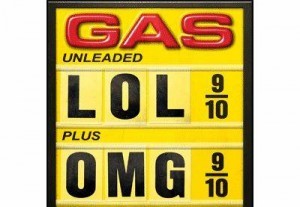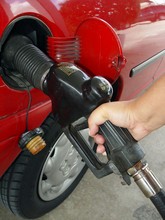 Who would have imagined 2 years ago that we would be paying $4 or more for a tank of gas? Well, believe it or not, it’s a reality.
Who would have imagined 2 years ago that we would be paying $4 or more for a tank of gas? Well, believe it or not, it’s a reality.
We appear to be in the midst of a gasoline crisis.
By the way, did you know that gas takes up 5% of the average household budget? That’s up 21% from a year ago!
While the New York Times debates the validity of there being an actual crisis, our pocketbooks say otherwise. And, CNBC points out that gas prices are, in fact, at full-blown crisis level.
I think the best way we can survive this hike in gas prices is to lower our need for gas.
Here are some simple things you can do to lower gas consumption and lessen the damage that gasoline prices are putting on your wallet:
#1 Take fewer trips to the store.
Americans are notorious for making numerous trips to the grocery store — sometimes twice in one day. Not only does this waste a great deal of time and cause you to make impulse purchases, but it is also hard on the gas tank.
It makes more sense to compile a list of the groceries you need, and go shopping once a month instead. Doing this, you could save up to 15 trips to the grocery store in a month — especially if you are the type that stops at the store every other day. If you treat the store as if it’s an hour’s drive away, (like people who live out in the country), then it would be easier to cut down on your trips to the grocery store.
Just the same, staying out of the stores at the mall will also keep you from buying things that you don’t need — like a single book, or another bra, or a new blouse. Instead, make a list of items as you realize the need for them, and then make a monthly trip to purchase items from your list.
#2 Pretend that you don’t have a car.
Imagine for a moment that you don’t have a car; think about how you would have to adjust. Where would you go? What would you do? Once you have that established, try to use your car only for emergencies or those times when you would have to call someone for a ride or take a cab. The more you can limit daily travel to places you can get to by foot, the more you’ll be saving on gas. (…And the more you’ll become physically fit!)
For example, try to set a “one-mile walk rule” — which means you stop driving to places that are less than one mile from you. It takes the average person 20 minutes to walk one mile, so you can easily get to places within a reasonable amount of time.
Some places to consider walking instead of driving:
- convenience store for milk or an ice cream cone
- school — when buses are not provided, or kids miss the bus
- neighborhood swimming pool or park
- library
- post office
See how a pipeline rupture in 2003 actually benefited residents of Phoenix Arizona.
#3 Use local services.
Think about how many dry cleaners you drive past on the way to your local dry cleaner. How far away is your doctor? Are you bypassing the chiropractor a half mile from your home to get to one that’s 20 miles away? Is your church a 15-minute walk away, or a 15-minute drive? Sure, you may be attached to these people, places, and services (and for very good reasons), so tearing yourself away may be as hard as breaking up a marriage. But in a time of crises (like today’s high gas prices), sometimes hard adjustments need to be made.
Just the same… try to support the local economy more by buying local produce, and purchasing your meat locally, as well.
#4 Consider moving.
If you live in an area where there are no local conveniences, or if you are far away from people who you spend the most time with, you may want to consider moving. While living 20 miles from your mother is a safe distance to ensure privacy, if one of you is having tough week and needs the other, it will put a toll on your gas tank.
In general, if your child’s school, your church, and all of your other activities happen to be in a particular area of town, perhaps you should be living in that area.
#5 Use the Internet.
Bargain shopping makes good sense, whether there’s a gasoline crisis or not. Comparing prices at different stores is just a smart thing to do before you make purchases. However, driving from store to store can quickly eat up any profits you might have made by finding an item at a lower price. Instead, use the Internet to compare prices. Odds are, you’ll find lower prices on the Net many times anyway (…even with shipping).
At the very least, whenever you’re shopping locally, call the stores on the phone and ask questions before driving there.
#6 Work from home, if at all possible.
While this was once a foreign concept that left employers suspicious that employees would be slacking off (on the company’s dollar), more and more employers have seen the light. They are finding that by allowing employees to work from home one or two days a week, they are actually more productive. Working from home saves you commute time and gas money. In addition, it can also save your employer money, energy, space, and resources, as well.
Do your research, and approach your employer with a brief presentation on how your working at home can benefit them. Hopefully your boss will respond like Arnold Schwarzenegger who is asking state workers in Sacramento to telecommute.
#7 Get to know your neighbors.
These are the people you are going to spend the most time with as gasoline prices continue to soar. In addition to your neighbors being the people you play with, you may be surprised to find that these can also be the people you work with.
For example, they may have a home business that supplies items you need. They may provide services that you want. They may be able to bring you business, as well. It might even make good sense to start a neighborhood business-marketing club that will benefit all involved.
#8 Carpool to work and play.
Talk to your co-workers and set up a carpool. Not only will you save money on gas, but you will all get to work faster using the carpool/HOV lanes. In fact, Washington area commuters are already choosing crowded cars over crowded roads as gas prices rise.
Just the same, consider carpooling to extra-curricular activities, as well. If your kids are in the same activities, if you’ll be heading to the same school events, if there’s a community activity nearby… both families will save time, money (and parking!) if you carpool sometimes.
Ways To Be Energy-Efficient And Save On Gas
 1. Pay attention to your tires.
1. Pay attention to your tires.
Under-inflated tires can cut your mileage per gallon by 5%. Also be sure to use the proper tires for the season.
2. Maintain a steady speed.
You can save up to 33% by maintaining steadier, slower speeds.
3. Change your car’s air filter regularly.
You should check it at each oil change to see if it needs to be changed. If so, save a few dollars by changing it yourself, rather than adding it on to your oil change bill.
4. Don’t use the air conditioner when in town.
When you’re driving at higher speeds, you’ll create a lot more drag and use a lot more fuel if your windows are rolled down. Using the AC anytime you’re driving below 40 mph makes the most sense.
5. Limit the cruise control.
Only use cruise control on flat roads. When you force your engine to rev up and down to maintain a fixed speed wastes gas.
6. Don’t idle or use the drive-thru.
Instead, park your car and go inside. Idling can waste up to a gallon of gas per hour. Starting the car actually uses the same amount of gasoline as 6 seconds of idling does.
7. Take excess “stuff” out of your car’s trunk.
That way, it’s not weighing down your car and burning more gas.
8. When you rent vehicles, go small.
The smaller the car, the better the mileage. Bonus: Small vehicles cost less to rent anyway.
9. Park in the first spot you find.
Rather than circling around the parking lot trying to find a spot close to the front, just park it and walk. Use the energy to burn calories while you walk, rather than burning fuel in your vehicle.
10. Don’t buy higher octane gas.
For most cars, it doesn’t make a difference. Really. So you’re just wasting money.
11. Slow down, rather than coming to a full stop whenever possible.
Not at stop signs, but at stop lights — whenever you see the light is about to change from red to green for you. Speeding up from 5 or 10 miles per hour uses less gas than starting from full stop does. Just the same, start slow after a full stop — rather than bursting out of the gate — if you want to save gas.
12. Don’t top off the gas tank.
Most of that gas leaks out and ends up on the road!
My Personal Favorites
Besides the gas savings tips mentioned above, there are a few other things I’ve done to squeeze as much gas out of the pump at each fill-up as possible:
As gas prices continue to rise, I find myself being a miser when it comes to gas. For example, if someone wants a ride that is on the way, I hint about chipping in on gas. If I forget something at the grocery store, I don’t make a special trip back to the store. I have a strict gas budget and will not budge on it. My reason for being so miserly when it comes to gas is my refusal to bow to higher prices than one’s ability to pay for gas. But all the same, paying high gas prices is not my idea of a good time.
One thing I do is to make note of the cheapest gas stations in my community. Then I only buy gas at those stations. This doesn’t mean that I waste a gallon of gas to save a few pennies though. It means that I time my gas purchases so that I don’t run out of gas until I will be in the particular neighborhood where gas is cheapest. Just in case I don’t make it, there are backup gas stations that I use. You could also use an app like GasBuddy to find the cheapest gas.
I always pay for my gas inside the station instead of at the pump. Why? Because I have been victim of credit card theft through devices added to gas pumps. Also, many gas stations will put a hold on your card for $50 even if you are only getting $20 worth of gas. The hold will stay there for several days.
Another thing I began doing awhile back is to pay close attention at the gas pump itself — like how to maximize how much gas actually goes into your car at each fill-up:
- Purchase your gasoline early in the morning. The ground temperature is at its coolest early in the day causing the gasoline to be denser. As the gas becomes warmer, it expands so one gallon of gas is actually less than a gallon. The pumps have no way to compensate for time of day or temperature.
- Let the gas flow slowly. This is difficult to do on cold or windy days, but forcing the gas from the pump as fast as you can causes some of the liquid to turn into a vapor that does not go into your car. The slower you pump, the more full your tank gets.
- Keep your gas tank full. I realize it is easy to neglect filling your gas tank when it’s not empty, especially with the gas prices we are dealing with. However, if your tank is full of air instead of gasoline, the gas you add to your car causes excess evaporation.
- Do not fill up your car when a gasoline trunk is pumping gas into the gas station. While this tip does nothing to save you money on gas, it can save you money on car maintenance and repairs. When gas is being pumped into a station, the gas is stirred up and dirt from the bottom of the gas pump may travel into your vehicle’s gas tank.
- Something I’ve noticed (when I pay for my gas inside the station, rather than at the pump) is that the gas pump clicks off before it dispenses the full amount of gas that I have paid for. So I find myself having to squeeze the pump 3 or 4 times in order to obtain the full amount of gasoline that I am due. In previous years, I probably would not have paid attention and lost about 50-cents to $1 worth of gasoline. Now, when I am satisfied that the number on the gas pump has reached the amount of money I have paid, I give the pump and extra squeeze and even a little shake to make sure all my gas goes in my car and not on the ground.



